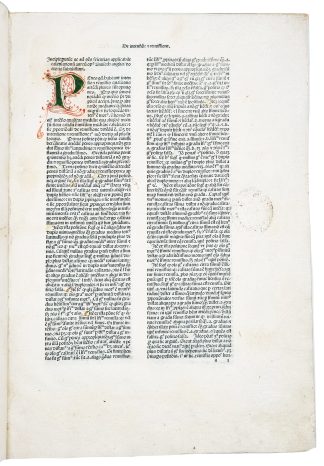SWINESHEAD, Richard.
INCUNABULAR MATHEMATICS – ONE COPY IN US
Opus aureum calculationum.
Pavia, Franciscus Girardengus, 4 Jan. 1498.£45,000.00
Folio. 324 x 226mm, ff. [80], a10 b-m6 n4. Gothic letter, double column. Blank foot of title (c.18 x 8cm) expertly repaired, few small light damp stains at blank gutter of first few ll., first two ll. lightly washed, a few painted lombard initials, ink splash on i4. A very good, wide-margined copy in C17 vellum, all edges sprinkled red and green, early ms title to spine, minor loss at foot. C18 partly rubbed ecclesiastical stamp (S. Franciscus Transtiberim?) to outer blank margin of a2, full-page ms ‘S Francisci Transtiberim Anno DMDCXXXX [1700] Jesus et Mariae’ (faded) to last verso (blank), occasional C16 ms marginalia or maniculae.
A fine wide-margined copy of the second edition of this most important C14 theoretical mathematical work – ‘the first to apply mathematics to natural science’ (Leibnitz). Incunables on applied or theoretical mathematics, and works on these subjects written by English authors and published before 1500, are very rare. Richard Swineshead (or Suiseth or Suisset, fl.1340-54) was a mathematician and natural philosopher, and a member of the ‘Oxford Calculators’ at Merton College. The ‘Liber Calculationum’ (c.1350) was first printed in 1477 and here edited by the medicine professor Giovanni da Tollentino, probably comparing the first edition with a manuscript preserved in Pavia, preserving the frequent medieval abbreviations. The ‘incipit’ of ‘Liber calculationum’ (c.1350) calls it ‘a very useful golden book on calculations which can be applied to all the sciences’. ‘Swineshead presupposes an Aristotelian/Neoplatonic physics, and searches for a logically adequate, mathematically precise account of it […]. He considers imaginary, physically impossible cases as long as they are not logically contradictory […]’ (Longeway, p.468). The 12 chapters begin by analysing the degrees of qualities (intension and remission), e.g. heat, according to whether their degree is uniform or not uniform; rarity and density (I.e., ‘the proportion of quantity of matter to volume’); the power of an action (maximum and minimum) and of resistance when a body interacts with another; the movement of a body towards the centre of the earth (which, albeit moving slower and slower, it will never reach); light and how it illuminates and reflects over a body or medium, a theory based on ‘simple geometrical visualization’ and influenced by Grosseteste; and local motion, considering ‘force, resistance and velocity’ as well as ‘the mean-speed theorem’ (Longeway, p.468). Most interesting is the ‘registrum’ at rear, which does not specify the number of leaves in each gathering, but rather specifies the first one or two words on the recto of the leaves in the first half of each gathering. The C16 annotator was interested in local motion and resistance, glossing the beginning of the chapter.
Only Huntington copy recorded in the US. ISTC is00831000; Goff S831; HC 15138*; BMC VII 1005; BSB-Ink S-622; GW M44277; Shaaber S377; Smith, p.10 (mentioned). R. Podkoński, ‘Swineshead’s Liber calculationum in Italy’, Recherches de théologie et philosophie médiévales, 80 (2013), pp. 307-61; Medieval Science, Technology, and Medicine (2014).In stock





